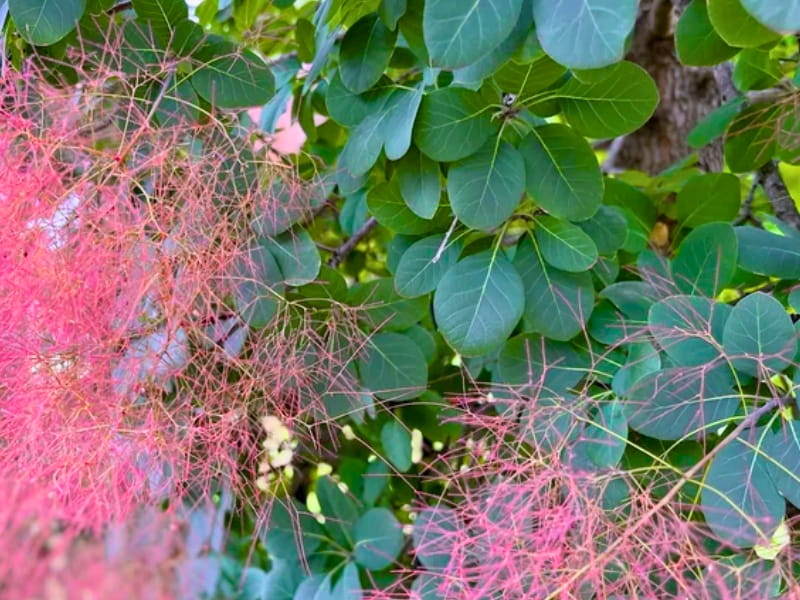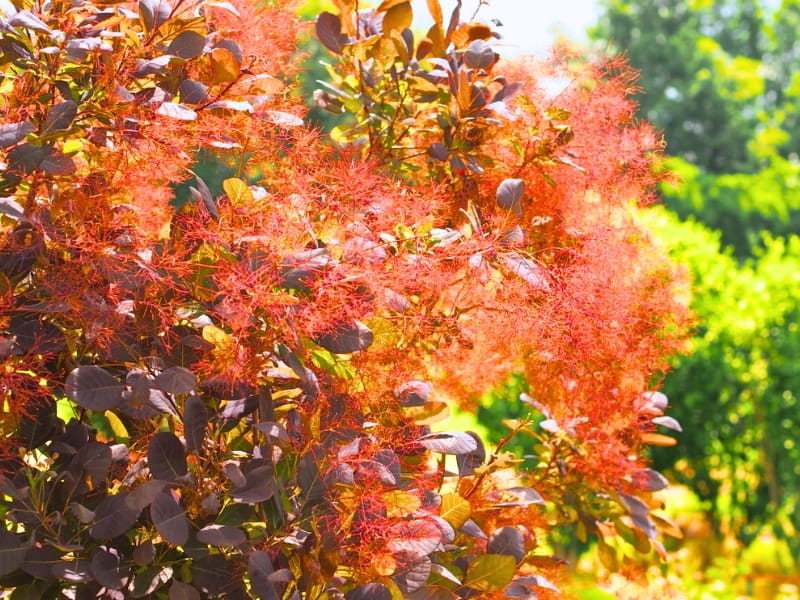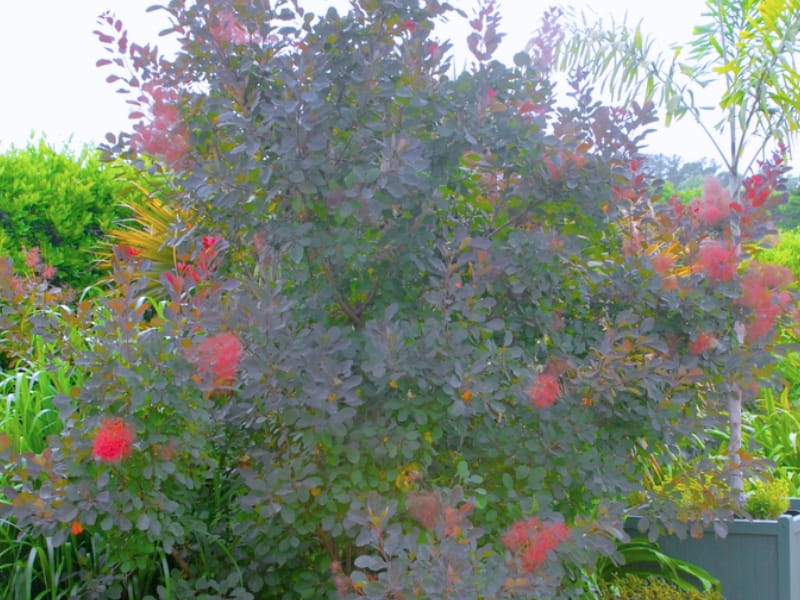The American Smoke Tree, also commonly known as American Smokebush, Chittamwood, or Cotinus obovatus, is a truly spectacular deciduous shrub or small tree, renowned for its wispy, smoke-like plumes and vibrant fall foliage. These landscape showstoppers offer multi-season interest, making them a valuable addition to any garden.
At Gardencenterpoint.com, we understand the desire to cultivate unique and captivating plants. This guide offers a comprehensive solution for anyone looking to successfully grow and enjoy the American Smoke Tree, from understanding its specific planting requirements to exploring different varieties available for purchase.
Imagine a plant that transforms your garden into a living canvas of color and texture throughout the year. Picture delicate, airy plumes that resemble puffs of smoke, followed by a breathtaking display of fiery autumnal hues. This isn’t a fantasy; it’s the reality of the American Smoke Tree. This captivating species offers a unique blend of visual drama and relatively low-maintenance care, making it a favorite among both novice and experienced gardeners. Its adaptability and striking appearance ensure it stands out, whether used as a focal point, a dramatic backdrop, or part of a mixed border. The visual impact is undeniable, and the rewards of incorporating this tree into your landscape are plentiful.

The American Smoke Tree has a rich history rooted in the Southeastern United States. Native Americans utilized various parts of the plant for medicinal purposes and dye production. A bright yellow dye, extracted from the wood, was particularly valued. The scientific name, Cotinus obovatus, reflects its botanical heritage: “Cotinus” refers to the ancient Greek name for wild olive, while “obovatus” describes the characteristic obovate (inverted egg-shaped) leaves.
The tree’s natural habitat spans from Tennessee and Alabama to Oklahoma and Texas, often found on rocky, well-drained slopes and limestone glades. This inherent hardiness contributes to its adaptability to a range of garden conditions, provided the soil is not consistently wet. While it thrives in its native regions, the American Smoke Tree has proven its resilience and adaptability in a variety of climates, extending its range considerably with proper care.
In the early 20th century, landscape architects and horticulturists began to recognize the ornamental potential of the American Smoke Tree. Selective breeding programs led to the development of cultivars with enhanced fall color and more compact growth habits, making them even more suitable for residential landscapes.
American Smoke Tree: Characteristics and Varieties
The American Smoke Tree is a multi-stemmed deciduous shrub or small tree, typically reaching a height and spread of 10 to 20 feet, although some specimens can grow larger in ideal conditions. Its most distinctive feature is the appearance of the flower clusters. While the individual flowers are small and insignificant, the elongated stalks (pedicels) that hold them are covered in fine hairs. These hairs persist after the flowers fade, creating the fluffy, smoke-like effect that gives the tree its name. This “smoke” typically appears in late spring or early summer and can range in color from pale pink to smoky purple, depending on the cultivar.
| Common name | American Smoke Tree, Chittamwood, American Smoketree |
| Botanical name | Cotinus obovatus |
| Family | Anacardiaceae |
| Genus | Cotinus |
| Species | obovatus |
| Origin | Southeastern United States |
| Native | Yes |
| Life cycle | Perennial |
| Plant type | Deciduous Tree or Large Shrub |
| Hardiness zone | 4, 5, 6, 7, 8, 9 |
| Sunlight | Full Sun |
| Maintenance | Low to Moderate |
| Water | Low to Moderate (Drought Tolerant once established) |
| Drainage | Well-Drained |
| Spacing | 15-20 ft. (depending on desired size and use) |
| Flowering period | Late Spring to Early Summer |
| Height | 20-30 ft. (can reach up to 50 ft. in ideal conditions) |
| Spread | 20-30ft |
| Growth rate | Moderate (1-2 feet per year) |
| Flower color | Pink to Tan (Panicles create a smoky appearance) |
| Leaf color | Blue-Green in Spring/Summer, turning vibrant shades of Yellow, Orange, Red, and Purple in Fall. |
| Stem color | Light Brown to Grayish-Brown |
| Fall color | Yellow, orange, red, purple |
| Flower benefit | Unique visual interest, attracts pollinators |
| Bark | Scaly when mature. |
| Garden style | Cottage, Woodland, Naturalistic, Specimen Plant |
| Uses | Ornamental, Specimen Tree, Small Shade Tree, Fall Color Accent, Border Planting, Wildlife Habitat (provides food and shelter for birds) |
| Soil pH | Adaptable, but prefers slightly acidic to neutral (6.0-7.5) |
| Soil type | Adaptable, but prefers well-drained loam, clay, or sandy soils. Avoids wet soil. |
| Drought Tolerance | High, once mature. |
| Deer Resistance | Moderate to High |
| Pollination | Insects |
| Propagation | Seed, softwood cuttings. |
| Pest and diseases | Generally resistant, occasionally susceptible to leaf spot, verticillium wilt, and powdery mildew. |
The foliage is another significant attraction. The leaves are obovate, meaning they are wider at the tip than at the base, and typically 3 to 5 inches long. They emerge a bluish-green color in spring, maturing to a deeper green in summer. The real spectacle, however, arrives in the fall, when the leaves transform into a dazzling array of yellow, orange, red, and purple hues. This fall color is often considered superior to that of the related European Smoke Tree (Cotinus coggygria).
The bark of the American Smoke Tree is also noteworthy. On young branches, it is smooth and reddish-brown. As the tree matures, the bark becomes scaly and gray-brown, adding textural interest to the winter landscape.
Key Characteristics Summary:
| Feature | Description |
| Botanical Name | Cotinus obovatus |
| Common Names | American Smoke Tree, American Smokebush, Chittamwood, Wild Smoke Tree |
| Plant Type | Deciduous shrub or small tree |
| Mature Size | 10-20 feet tall and wide (can be larger) |
| “Smoke” Color | Pale pink to smoky purple (depending on cultivar) |
| Leaf Shape | Obovate (wider at the tip) |
| Fall Color | Yellow, orange, red, and purple |
| Bark | Smooth and reddish-brown (young branches), scaly and gray-brown (mature) |
| Hardiness Zones | USDA Zones 4-8 |
| Sun Exposure | Full sun (at least 6 hours per day) |
| Soil Preference | Well-drained, average soil; tolerates alkaline and rocky soils |
| Water Needs | Moderate; drought-tolerant once established |
| Bloom Time | Late spring to early summer (for the “smoke” effect) |
| Wildlife Value | Provides cover for birds and small mammals; flowers attract some pollinators, although not a major source of nectar. |

Popular Varieties:
While the straight species (Cotinus obovatus) is a beautiful plant, several cultivars offer variations in size, “smoke” color, and fall foliage intensity. Some popular choices include:
- ‘Grace’: A hybrid between C. obovatus and C. coggygria ‘Velvet Cloak’. Known for its vigorous growth, large size (up to 20 feet), and vibrant reddish-purple smoke. Fall color is outstanding.
- ‘Golden Spirit’ (‘Ancot’): A unique cultivar with chartreuse to golden-yellow foliage throughout the growing season. The smoke is a soft pink. Fall color is a mix of orange, red, and yellow.
- Unnamed Seedlings: Many nurseries offer seedlings of Cotinus obovatus that are not specific cultivars. These are often more affordable and still provide excellent fall color, although there may be some variability in appearance.
Choosing the right variety depends on your specific needs and preferences. Consider the available space, desired “smoke” color, and foliage characteristics when making your selection.
Planting and Caring for Your American Smoke Tree: A Step-by-Step Guide
Planting Your American Smoke Tree
Successful establishment begins with proper planting. Follow these steps:
- Timing: The best time to plant an American Smoke Tree is in the spring or fall, when the weather is cool and the soil is moist. Avoid planting during the hottest part of summer or the coldest part of winter.
- Location: Choose a location that receives full sun (at least 6 hours of direct sunlight per day). The American Smoke Tree is relatively adaptable to different soil types, but it must have well-drained soil. Avoid planting in areas where water tends to collect, as this can lead to root rot.
- Soil Preparation: While the American Smoke Tree tolerates poor soils, amending the planting area with compost or other organic matter can improve drainage and provide essential nutrients. If your soil is heavy clay, consider creating a raised bed or berm to improve drainage.
- Planting Hole: Dig a hole that is twice as wide as the root ball of the tree and just as deep. Gently loosen any circling roots around the outside of the root ball before planting.
- Planting Depth: Position the tree in the hole so that the top of the root ball is level with or slightly above the surrounding soil. This ensures that the root flare (where the trunk meets the roots) is not buried, which can lead to problems.
- Backfilling: Fill the hole with the amended soil, gently tamping it down to remove air pockets. Water thoroughly after planting to settle the soil.
- Spacing Plant on 15 foot centers to allow for a natural growth.
Watering and Fertilizing
- Watering: Newly planted American Smoke Trees require regular watering to establish a strong root system. Water deeply once or twice a week, depending on rainfall and weather conditions. Once established, the tree is relatively drought-tolerant and requires less frequent watering. However, during prolonged periods of drought, supplemental watering may be necessary. A good rule of thumb is to water deeply when the top few inches of soil feel dry to the touch.
- Fertilizing: American Smoke Trees are not heavy feeders and generally do not require a lot of fertilizer. In fact, over-fertilizing can lead to excessive growth and reduced flowering. If your soil is poor, you can apply a balanced, slow-release fertilizer in early spring, following the package instructions carefully. A soil test can help determine if fertilization is necessary.
Pruning and Maintenance
- Pruning: The American Smoke Tree requires minimal pruning. The best time to prune is in late winter or early spring, before new growth begins. Remove any dead, damaged, or crossing branches. You can also selectively prune to shape the tree or control its size. However, avoid heavy pruning, as this can reduce the “smoke” effect. If you want to rejuvenate an older tree, you can cut it back hard to the ground in late winter. This will stimulate vigorous new growth, but you will lose the “smoke” for that year.
- Pest and Disease Control: The American Smoke Tree is generally resistant to pests and diseases. However, it can occasionally be affected by verticillium wilt, a fungal disease that can cause wilting and dieback of branches. Proper planting and care can help prevent this disease. If you notice any signs of verticillium wilt, contact your local extension office for advice. Leaf spot and powdery mildew may occasionally occur but are rarely serious.
Propagation
- Seed: American Smoke Trees can be propagated from seed, although the resulting plants may not be true to the parent cultivar. Collect seeds in the fall after the “smoke” has faded. The seeds require a period of cold stratification (exposure to cold temperatures) to germinate. Sow the seeds outdoors in the fall or stratify them in the refrigerator for 90-120 days before sowing in the spring.
- Cuttings: Softwood cuttings, taken in late spring or early summer, are a more reliable method of propagation for maintaining the characteristics of a specific cultivar. Dip the cut ends in rooting hormone and place them in a well-drained potting mix. Keep the cuttings moist and humid until roots develop.
- Layering: Air layering is another option.

Winter Care
No additional care is needed in the winter.
Potential Problems and Solutions
While generally trouble-free, here are some potential issues:
- Verticillium Wilt: As mentioned above, this fungal disease can be serious. Prevention is key: ensure good drainage and avoid overwatering.
- Poor Fall Color: Lack of sunlight is the most common cause. Ensure your tree receives at least 6 hours of direct sun per day. Nutrient deficiencies can also play a role, so a soil test may be helpful.
- Leggy Growth: This can be caused by over-fertilization or insufficient sunlight. Prune to encourage bushier growth and ensure adequate light.
Uses in the Landscape
The American Smoke Tree is a versatile plant with a variety of landscape applications:
- Specimen Plant: Its unique form and stunning fall color make it an excellent focal point in the garden.
- Mass Planting: Create a dramatic visual impact by planting several trees together.
- Mixed Border: Combine it with other shrubs and perennials for a layered effect.
- Wildlife Garden: Provides cover for birds and small mammals.
- Erosion Control: Its deep root system helps stabilize slopes.
- Screen or Hedge: When planted closer together, it can form an informal screen or hedge.
Companion Plants
Choose companions that share similar growing requirements (full sun, well-drained soil):
- Ornamental Grasses: Their airy texture complements the “smoke” of the tree. Examples include Switchgrass (Panicum virgatum) and Little Bluestem (Schizachyrium scoparium).
- Conifers: Provide a contrasting evergreen backdrop. Examples include Junipers (Juniperus spp.) and Dwarf Pines (Pinus mugo).
- Flowering Perennials: Add seasonal color and interest. Examples include Coneflowers (Echinacea purpurea), Black-Eyed Susans (Rudbeckia hirta), and Sedums (Hylotelephium spp.).
- Other Shrubs with Fall Color: Enhance the autumnal display. Examples include Oakleaf Hydrangea (Hydrangea quercifolia) and Fothergilla (Fothergilla spp.).
Frequently Asked Questions (FAQ)
- Q: Is the American Smoke Tree deer-resistant?
- A: The American Smoke Tree is considered moderately deer-resistant. While deer may browse on it occasionally, they generally prefer other plants.
- Q: Is the American Smoke Tree poisonous?
- A: The American Smoke Tree is not considered toxic to humans or pets. However, some people may experience mild skin irritation from contact with the sap, so it’s best to wear gloves when pruning.
- Q: How fast does the American Smoke Tree grow?
- A: The growth rate is moderate, typically 1-2 feet per year.
- Q: Can I grow an American Smoke Tree in a container?
- A: Yes, smaller cultivars can be grown in large containers with good drainage. Choose a pot that is at least 24 inches in diameter and use a high-quality potting mix.
- Q: When will my newly planted tree display smoke.
- A: Most plants will smoke lightly the year after planting, increasing the display each subsequent year.

Leave a Reply